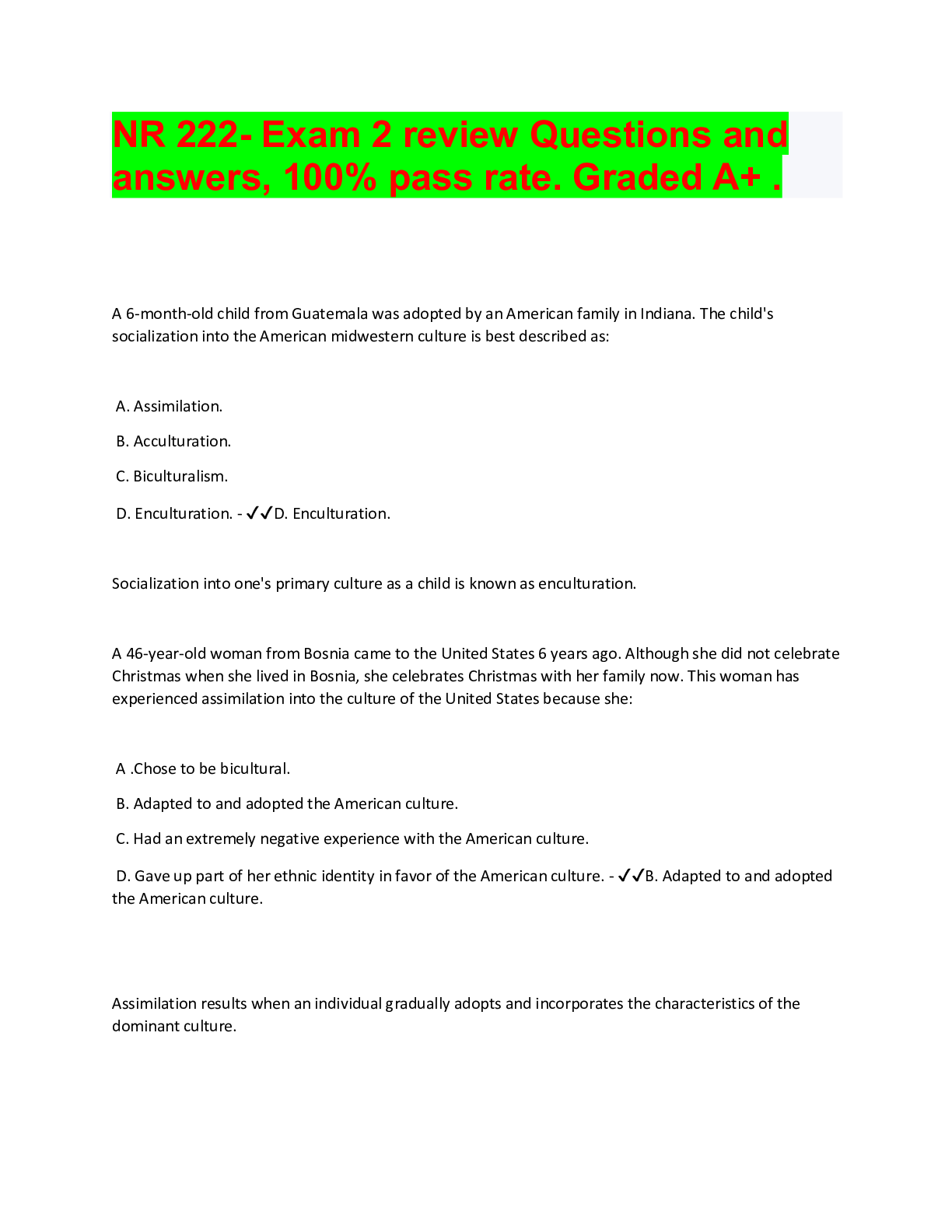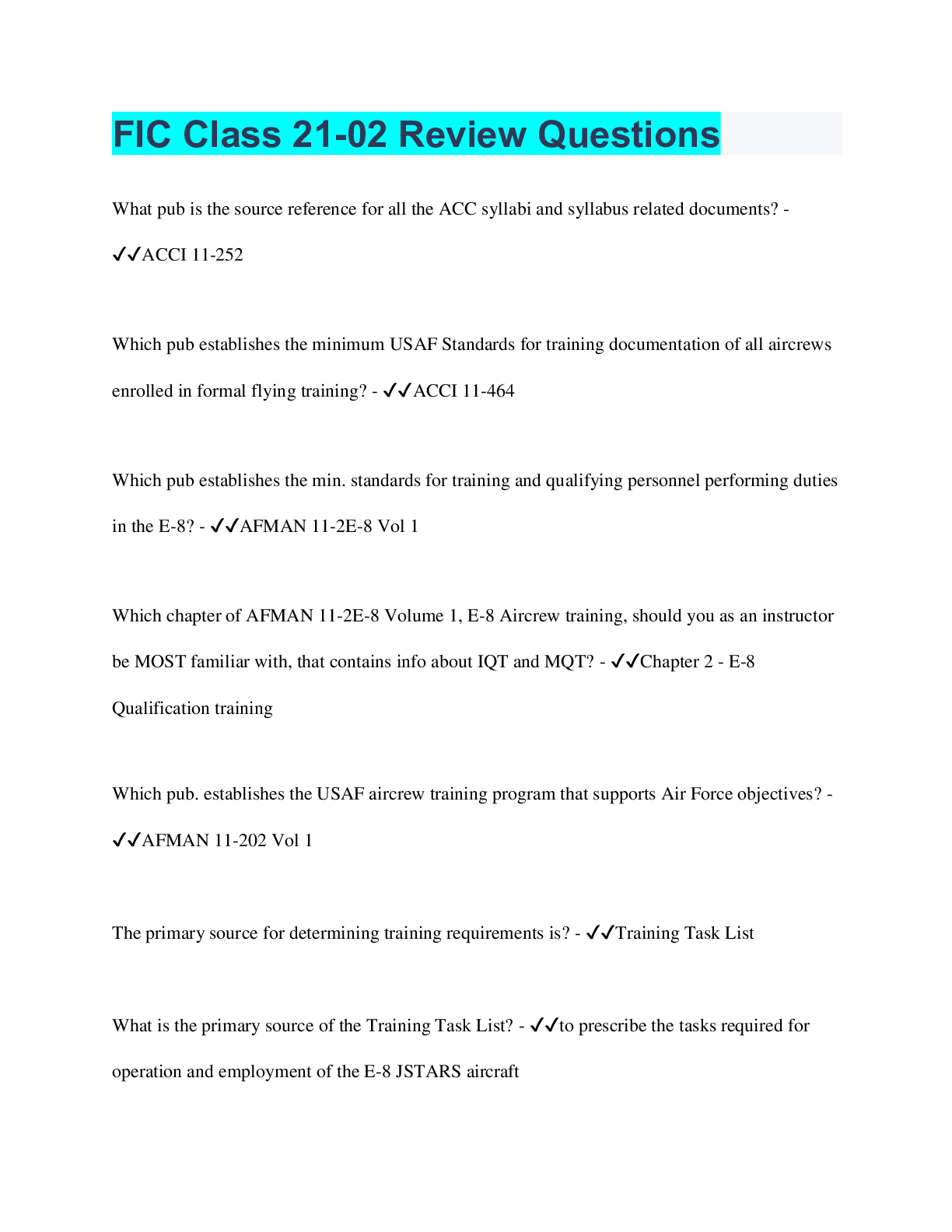*NURSING > QUESTIONS & ANSWERS > NR327 Exam 2 Review Questions #9 Care of the High-Risk Mother, Newborn & Family With Special Needs ( (All)
NR327 Exam 2 Review Questions #9 Care of the High-Risk Mother, Newborn & Family With Special Needs (aka Postpartum Maternal Complications) (28)
Document Content and Description Below
2/5/2019 (9) ✅ NR327 Exam 2 Review Questions #9 Care of the High-Risk Mother, Newborn & Family With Special Needs (aka Postpartum Mater… https://docs.google.com/forms/d/1TRbahmm6nSQEZBUCeWVYbaNyd... gu69GGQv3jra6b2sXs/edit 1/10 (9) ✅ NR327 Exam 2 Review Questions #9 Care of the High-Risk Mother, Newborn & Family With Special Needs (aka Postpartum Maternal Complications) (28) https://quizlet.com/139276120/m-ch-28-flash-cards/ * Required 1. 1. Which statement by a postpartum client indicates that further teaching is not needed regarding thrombus formation? * Mark only one oval. a. "I'll keep my legs elevated with pillows." b. "I'll sit in my rocking chair most of the time." c. "I'll stay in bed for the first 3 days after my baby is born." d. "I'll put my support stockings on every morning before rising." 2. 2. The nurse knows that late postpartum hemorrhage can be prevented by: * Mark only one oval. a. manually removing the placenta. b. inspecting the placenta after birth. c. administering broad-spectrum antibiotics. d. pulling on the umbilical cord to hasten the birth of the placenta 3. 3. A multiparous client is admitted to the postpartum unit after a rapid labor and birth of a 4000-g infant. Her fundus is boggy, lochia is heavy, and vital signs are unchanged. The nurse has the client void and massages her fundus, but the fundus remains difficult to find and the rubra lochia remains heavy. Which action should the nurse take next? * Mark only one oval. a. Recheck vital signs. b. Insert a Foley catheter. c. Notify the health care provider. d. Continue to massage the fundus. 4. 4. Early postpartum hemorrhage is defined as a blood loss greater than: * Mark only one oval. a. 500 mL within 24 hours after a vaginal birth. b. 750 mL within 24 hours after a vaginal birth. c. 1000 mL within 48 hours after a cesarean birth. d. 1500 mL within 48 hours after a cesarean birth.2/5/2019 (9) ✅ NR327 Exam 2 Review Questions #9 Care of the High-Risk Mother, Newborn & Family With Special Needs (aka Postpartum Mater… https://docs.google.com/forms/d/1TRbahmm6nSQEZBUCeWVYbaNydgu69GGQv3jra6b2sXs/edit 2/10 5. 5. A steady trickle of bright red blood from the vagina in the presence of a firm fundus suggests: * Mark only one oval. a. uterine atony. b. perineal hematoma. c. infection of the uterus. d. lacerations of the genital tract. 6. 6. A postpartum client would be at increased risk for postpartum hemorrhage if she delivered a(n): * Mark only one oval. a. 5-lb, 2-oz infant with outlet forceps. b. 6.5-lb infant after a 2-hour labor. c. 7-lb infant after an 8-hour labor. d. 8-lb infant after a 12-hour labor. 7. 7. Which instruction should be included in the discharge teaching plan to assist the client in recognizing early signs of complications? * Mark only one oval. a. Palpate the fundus daily to ensure that it is soft. b. Report any decrease in the amount of brownish red lochia. c. The passage of clots as large as an orange can be expected. d. Notify the health care provider of any increase in the amount of lochia or a return to bright red bleeding. 8. 8. The nurse should expect medical intervention for subinvolution to include: * Mark only one oval. a. oral fluids to 3000 mL/day. b. intravenous fluid and blood replacement. c. oxytocin intravenous infusion for 8 hours. d. oral methylergonovine maleate (Methergine) for 48 hours. 9. 9. If nonsurgical treatment for subinvolution is ineffective, which surgical procedure is appropriate to correct the cause of this condition? * Mark only one oval. a. Hysterectomy b. Laparoscopy c. Laparotomy d. Dilation and curettage (D&C)2/5/2019 (9) ✅ NR327 Exam 2 Review Questions #9 Care of the High-Risk Mother, Newborn & Family With Special Needs (aka Postpartum Mater… https://docs.google.com/forms/d/1TRbahmm6nSQEZBUCeWVYbaNydgu69GGQv3jra6b2sXs/edit 3/10 10. 10. A sign of thrombophlebitis is: * Mark only one oval. a. visible varicose veins. b. positive Homans sign. c. pedal edema in the affected leg. d. local tenderness, heat, and swelling. 11. 11. Which nursing measure would be appropriate to prevent thrombophlebitis in the recovery period following a cesarean birth? * Mark only one oval. a. Limit the client's oral intake of fluids for the first 24 hours. b. Assist the client in performing leg exercises every 2 hours. c. Ambulate the client as soon as her vital signs are stable. d. Roll a bath blanket and place it firmly behind the client's knees. 12. 12. Which temperature indicates the presence of postpartum infection? * Mark only one oval. a. 99.6° F in the first 48 hours b. 100° F for 2 days postpartum c. 100.4° F in the first 24 hours d. 100.8° F on the second and third postpartum days 13. 13. A white blood cell (WBC) count of 35,000 cells/mm3 on the morning of the first postpartum day indicates: * Mark only one oval. a. possible infection. b. normal WBC limit. c. serious infection. d. suspicion of a sexually transmitted disease. 14. 14. The client who is being treated for endometritis is placed in the Fowler position because it: * Mark only one oval. a. promotes comfort and rest. b. facilitates drainage of lochia. c. prevents spread of infection to the urinary tract. d. decreases tension on the reproductive organs.2/5/2019 (9) ✅ NR327 Exam 2 Review Questions #9 Care of the High-Risk Mother, Newborn & Family With Special Needs (aka Postpartum Mater… https://docs.google.com/forms/d/1TRbahmm6nSQEZBUCeWVYbaNydgu69GGQv3jra6b2sXs/edit 4/10 15. 15. Nursing measures that help prevent postpartum urinary tract infection include: * Mark only one oval. a. forcing fluids to at least 3000 mL/day. b. promoting bed rest for 12 hours after birth. c. encouraging the intake of orange, grapefruit, or apple juice. d. discouraging voiding until the sensation of a full bladder is present. 16. 16. Which measure may prevent mastitis in a breastfeeding client? * Mark only one oval. a. Wearing a tight-fitting bra b. Applying ice packs prior to feeding c. Initiating early and frequent feedings d. Nursing the infant for 5 minutes on each breast 17. 17. A client with mastitis is concerned about breastfeeding while she has an active infection. Which is an appropriate response by the nurse? * Mark only one oval. a. Organisms will be inactivated by gastric acid. b. Organisms that cause mastitis are not passed to the milk. c. The infant is not susceptible to the organisms that cause mastitis. d. The infant is protected from infection by immunoglobulins in the breast milk. 18. 18. The nurse expecting a uterine infection in a postpartum client should assess the: * Mark only one oval. a. episiotomy site. b. odor of the lochia. c. abdomen for distention. d. pulse and blood pressure 19. 19. Following a difficult vaginal birth of a singleton pregnancy, the client starts bleeding heavily. Clots are expressed and a Foley catheter is inserted to empty the bladder because the uterine fundus is soft and displaced laterally from midline. Vital signs are 99.8° F, pulse 90 beats/min, respirations 20 breaths/min, and BP 130/90 mm Hg. Which pharmacologic intervention is indicated? * Mark only one oval. a. Oxytocin (Pitocin) to be administered in a piggyback solution b. Administration of methylergonovine (Methergine) c. Administration of prostaglandin analogue d. Increase in parenteral fluids2/5/2019 (9) ✅ NR327 Exam 2 Review Questions #9 Care of the High-Risk Mother, Newborn & Family With Special Needs (aka Postpartum Mater… https://docs.google.com/forms/d/1TRbahmm6nSQEZBUCeWVYbaNydgu69GGQv3jra6b2sXs/edit 5/10 20. 20. Following a vaginal birth, a client has lost a significant amount of blood and is starting to experience signs of hypovolemic shock. Which clinical signs would be consistent with this clinical diagnosis? * Mark only one oval. a. Decrease in blood pressure, with an increase in pulse pressure b. Compensatory response of tachycardia and decreased pulse pressure c. Decrease in heart rate and an increase in respiratory effort d. Flushed skin 21. 21. A client has been treated with oxytocin (Pitocin) for postpartum hemorrhage. Bleeding has stabilized and slowed down considerably. The peripad in place reveals a moderate amount of bright red blood, with no clots expelled when massaging the fundus. The client now complains of having difficulty breathing. Auscultation of breath sounds reveals adventitious sounds. Based on this clinical presentation, the priority nursing action is to: * Mark only one oval. a. evaluate intake and output of the past 12 hours following birth. b. initiate a rapid response intervention. c. obtain an order from the physician for type and crossmatch of 2 units packed red blood cells (PRBCs). d. reposition the client and reassess in 15 minutes. Initiate frequent vital sign assessments. 22. 22. A postpartum client has developed deep vein thrombosis (DVT) and treatment with warfarin (Coumadin) has been initiated. Which dietary selection should be modified in view of this treatment regimen? * Mark only one oval. a. Fresh fruits b. Milk c. Lentils d. Soda 23. 23. The nurse recognizes that infection may be present in her postpartum client when the client exhibits a temperature of: * Mark only one oval. a. 100.0° F during the first 36 hours postpartum. b. 100.8° F twice in the first 24 hours postpartum. c. 99.6° F on the first postpartum day and 100.4 on the second. d. 100.4° F on the second postpartum day and 100.8° F on the fourth. 24. 24. To determine an adverse response to carboprost tromethamine (Hemabate), the nurse should frequently assess: * Mark only one oval. a. temperature. b. lochial flow. c. fundal height. d. breath sounds.2/5/2019 (9) ✅ NR327 Exam 2 Review Questions #9 Care of the High-Risk Mother, Newborn & Family With Special Needs (aka Postpartum Mater… https://docs.google.com/forms/d/1TRbahmm6nSQEZBUCeWVYbaNydgu69GGQv3jra6b2sXs/edit 6/10 25. 25. Which labor and birth information on the client would suggest an increased risk for hemorrhage? * Mark only one oval. a. Precipitous birth after a 12-hour labor b. Cesarean birth of an infant weighing 8 lb, 4 oz c. Vaginal birth of 7-lb infant after a 2-hour labor d. Vaginal birth of 6-lb infant after a 7-hour labor 26. 26. If the nurse suspects a complication of a low forceps birth labor, she should immediately: * Mark only one oval. a. administer a strong oral analgesic. b. assess the perineal and vaginal areas. c. assess the position of the uterine fundus. d. review the labor record for duration of second stage. 27. 27. Prior to ambulating the client to the bathroom whose admission hemoglobin level was 10.2 g/dL, the nurse should: * Mark only one oval. a. request repeat hemoglobin and hematocrit. b. assess the resting pulse rate. c. dangle her on the side of the bed. d. administer the ordered oral analgesic. 28. 28. If a late postpartum hemorrhage is documented on a client who delivered 3 days ago, the nurse recognizes that this hemorrhage occurred: * Mark only one oval. a. on the first postpartum day. b. during recovery phase of labor. c. during the third stage of labor. d. on the second postpartum day. 29. 29. Which client data received during report should the nurse recognize as being a postpartum risk factor? * Mark only one oval. a. Gravida 5, para 5 b. Labor duration of 4 hours c. Infant weight greater than 3800 g d. Epidural anesthesia for labor and birth2/5/2019 (9) ✅ NR327 Exam 2 Review Questions #9 Care of the High-Risk Mother, Newborn & Family With Special Needs (aka Postpartum Mater… https://docs.google.com/forms/d/1TRbahmm6nSQEZBUCeWVYbaNydgu69GGQv3jra6b2sXs/edit 7/10 30. 30. Before administering methylergonovine (Methergine), the nurse checks the: * Mark only one oval. a. color of the lochia. b. blood pressure. c. location of the fundus. d. last administration of analgesics. 31. 31. To evaluate the desired response of methylergonovine (Methergine), the nurse would assess the client's: * Mark only one oval. a. uterine tone. b. pain level. c. blood pressure. d. last voiding 32. 32. Which data collected during your assessment may indicate a vaginal wall hematoma? * Mark only one oval. a. Firm uterus at U-1 b. Pulse rate of 110 bpm c. Moderate lochia d. Soreness of perineum 33. 33. As you receive a report, which assessment finding should you recognize as indicative of a vaginal laceration? * Mark only one oval. a. Fundus firm at the umbilicus b. Pulse of 90 bpm, blood pressure of 110/78 mm Hg c. Bright red continuous trickle of blood from vagina d. Client requested pain medication twice during last shift 34. 34. Which observation of your client as she ambulates could indicate development of a DVT (deep vein thrombosis)? * Mark only one oval. a. Slow gait b. Shuffling gait c. Stiffness of right leg d. Leans on husband for support2/5/2019 (9) ✅ NR327 Exam 2 Review Questions #9 Care of the High-Risk Mother, Newborn & Family With Special Needs (aka Postpartum Mater… https://docs.google.com/forms/d/1TRbahmm6nSQEZBUCeWVYbaNydgu69GGQv3jra6b2sXs/edit 8/10 35. 35. If a DVT (deep vein thrombosis) is suspected, the nurse should: * Mark only one oval. a. perform a Homans sign on the affected leg. b. dorsiflex the foot of the affected leg. c. palpate the affected leg for edema and pain. d. place the client on bed rest, with the affected leg elevated 36. 36. If the nurse suspects a pulmonary embolism in the client who suddenly complains of chest pain, she or he should immediately: * Mark only one oval. a. assess for abnormal breath sounds. b. apply O2 via tight face mask at 8 to 10 L/min. c. position the client in a supine position with the head of the bed flat. d. monitor pulse oximetry for decreased oxygen saturation. 37. 37. To prevent infection of the reproductive tract, the nurse should instruct the client to: * Mark only one oval. a. change the peripad once per shift. b. cleanse the perineum from front to back. c. perform pericare at least twice during the shift. d. increase fluid intake to 2500 to 3000 mL/day. 38. 38. For the client diagnosed with endometritis, the nurse recognizes that the client should be positioned in the: * Mark only one oval. a. prone position. b. side-lying position. c. Fowler position. d. supine position with the head flat. 39. 39. To prevent infection of the urinary tract, the nurse should instruct the client to: * Mark only one oval. a. include soft drinks in the total fluid intake. b. drink grapefruit juice several times a day. c. perform pericare at least twice during a shift. d. increase fluid intake to 2500 to 3000 mL/day.2/5/2019 (9) ✅ NR327 Exam 2 Review Questions #9 Care of the High-Risk Mother, Newborn & Family With Special Needs (aka Postpartum Mater… https://docs.google.com/forms/d/1TRbahmm6nSQEZBUCeWVYbaNydgu69GGQv3jra6b2sXs/edit 9/10 40. 40. What data in the client's history should the nurse recognize as being pertinent to a possible diagnosis of postpartum depression? * Mark only one oval. a. Teenage depression episode b. Unexpected operative birth c. Ambivalence during the first trimester d. Second pregnancy in a 3-year period 41. 41. The nurse notes that the fundus of a postpartum patient is boggy, shifted to the left of the midline, and 2 cm above the umbilicus. What is the nurse's priority action? * Mark only one oval. a. Massage the fundus of the uterus. b. Assist the patient out of bed to void. c. Increase the infusion of oxytocin (Pitocin). d. Ask another nurse to bring in a straight catheter tray. 42. 42. For the patient experiencing a postpartum hemorrhage, the health care provider prescribes methylergonovine (Methergine). What assessment must the nurse perform prior to administering this medication? * Mark only one oval. a. Heart rate b. Temperature c. Blood pressure d. Respiratory rate 43. 43. Which information should the nurse recognize as contributing to mastitis in the breastfeeding mother? (Select all that apply.) * Check all that apply. a. Insufficient emptying b. Feeding every 2 hours c. Supplementing feedings d. Blisters on both nipples e. Alternating breastfeeding positions 44. 44. The visiting nurse must be aware that women who have had a postpartum hemorrhage are subject to a variety of complications after discharge from the hospital. These include which of the following? (Select all that apply.) * Check all that apply. a. Anemia b. Dehydration c. Exhaustion d. Postpartum infection e. Failure to attach to her infant2/5/2019 (9) ✅ NR327 Exam 2 Review Questions #9 Care of the High-Risk Mother, Newborn & Family With Special Needs (aka Postpartum Mater… https://docs.google.com/forms/d/1TRbahmm6nSQEZBUCeWVYbaNydgu69GGQv3jra6b2sXs/edit 10/10 Powered by [Show More]
Last updated: 1 year ago
Preview 1 out of 10 pages
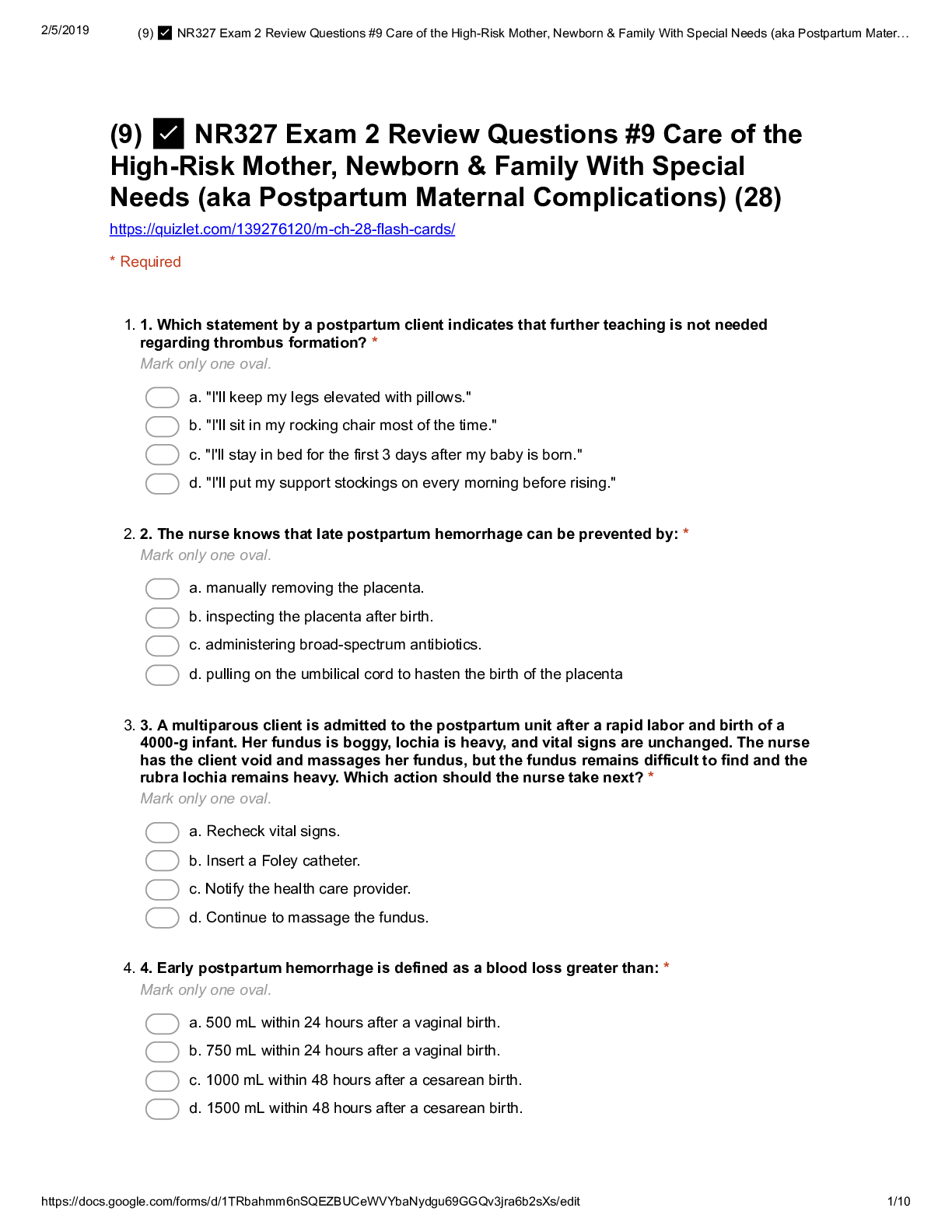
Reviews( 0 )
Document information
Connected school, study & course
About the document
Uploaded On
Apr 14, 2021
Number of pages
10
Written in
Additional information
This document has been written for:
Uploaded
Apr 14, 2021
Downloads
0
Views
51

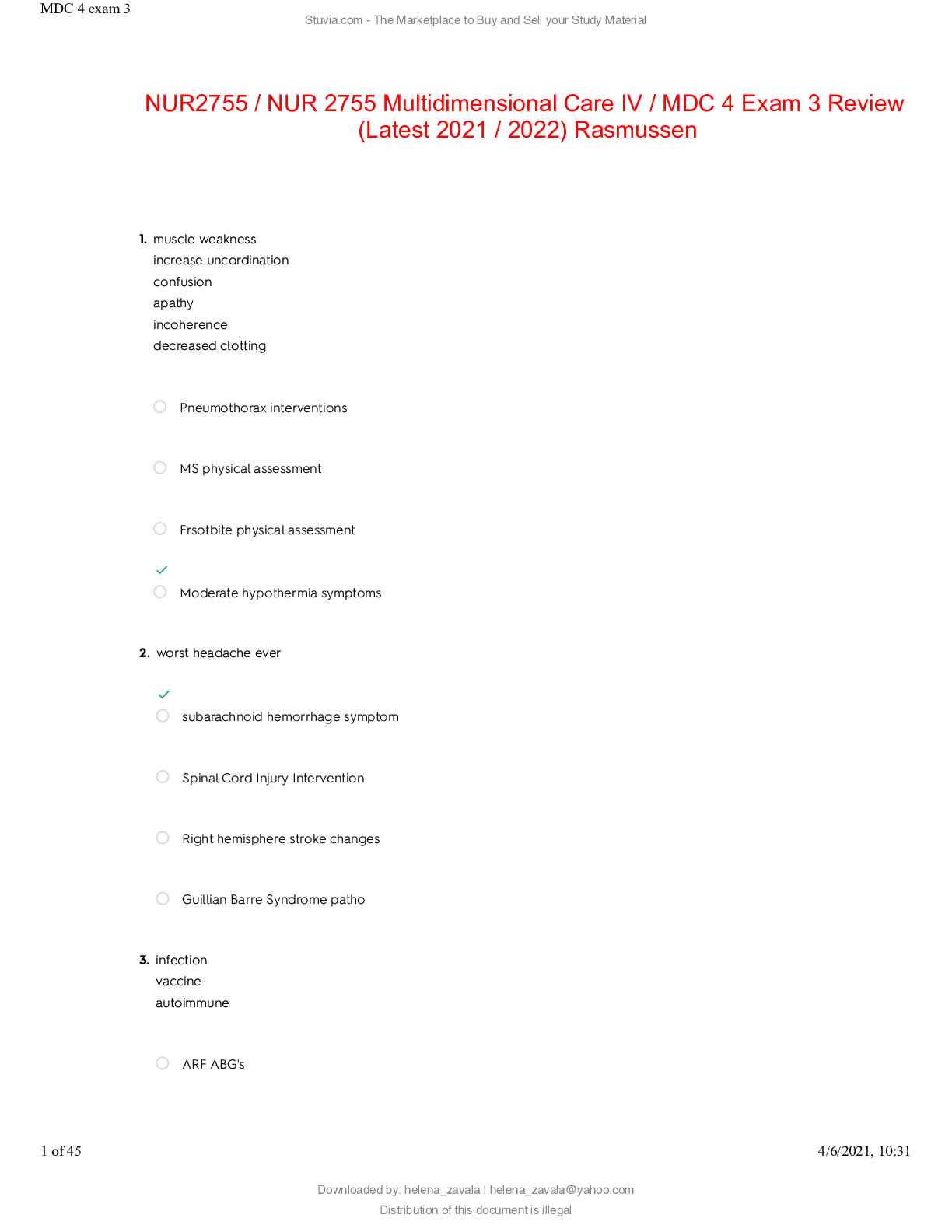
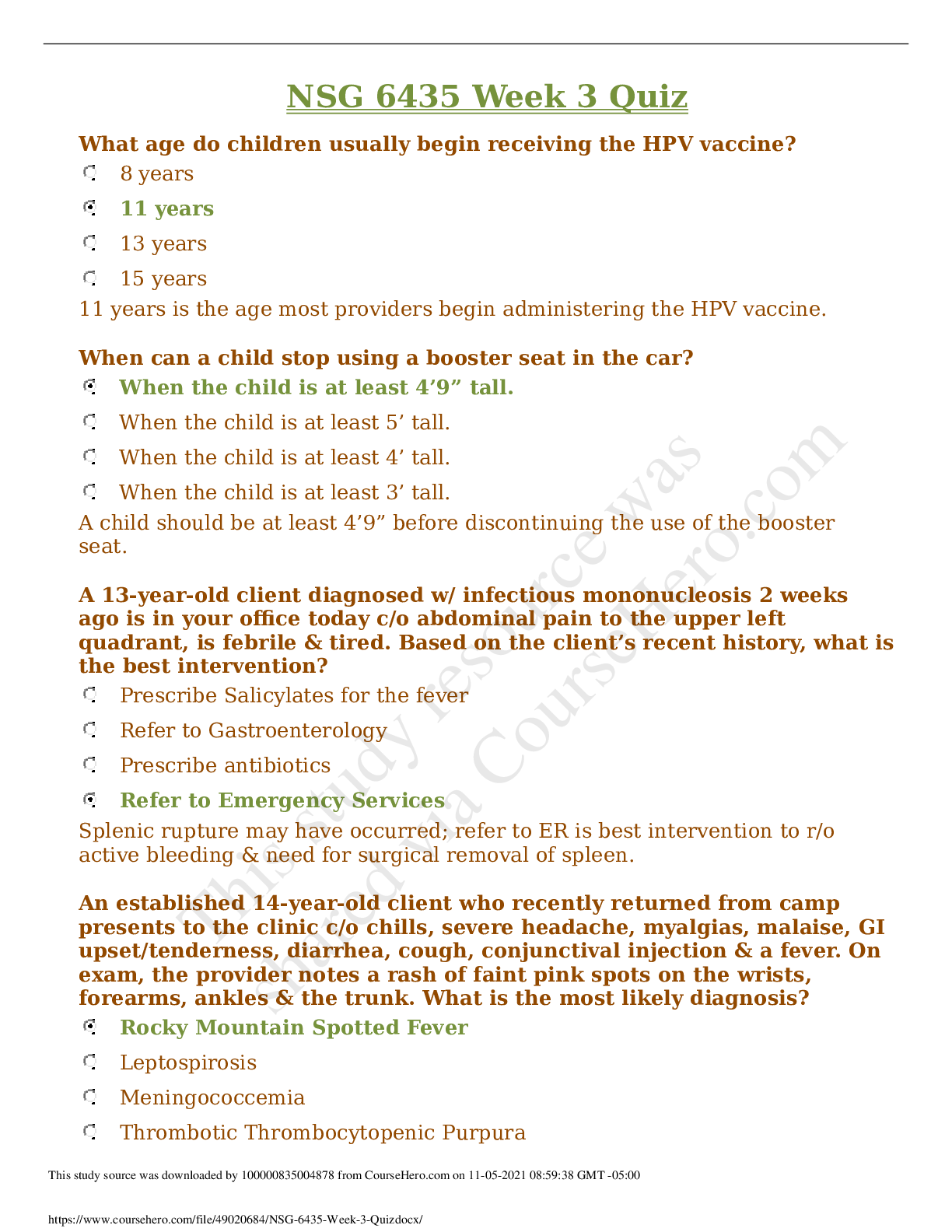



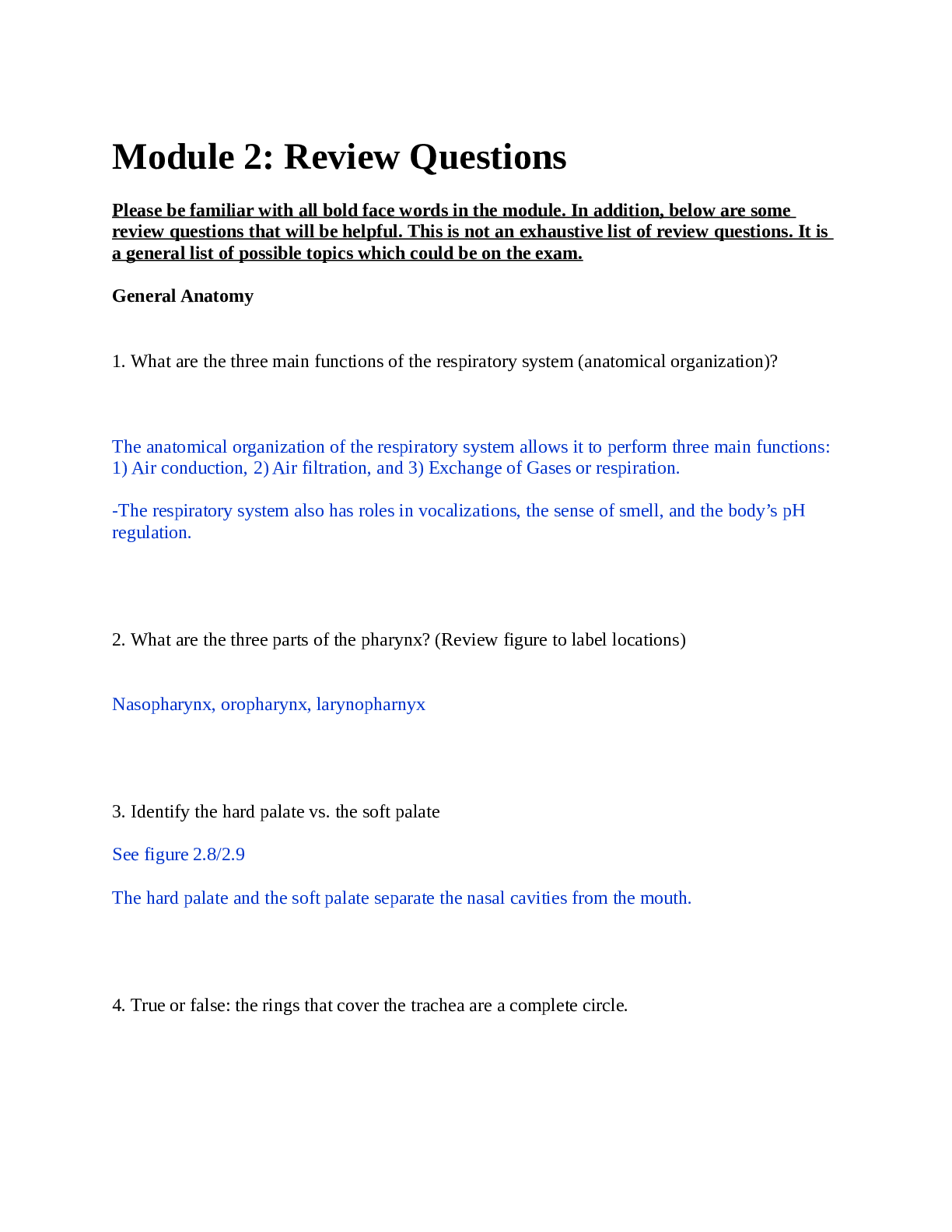
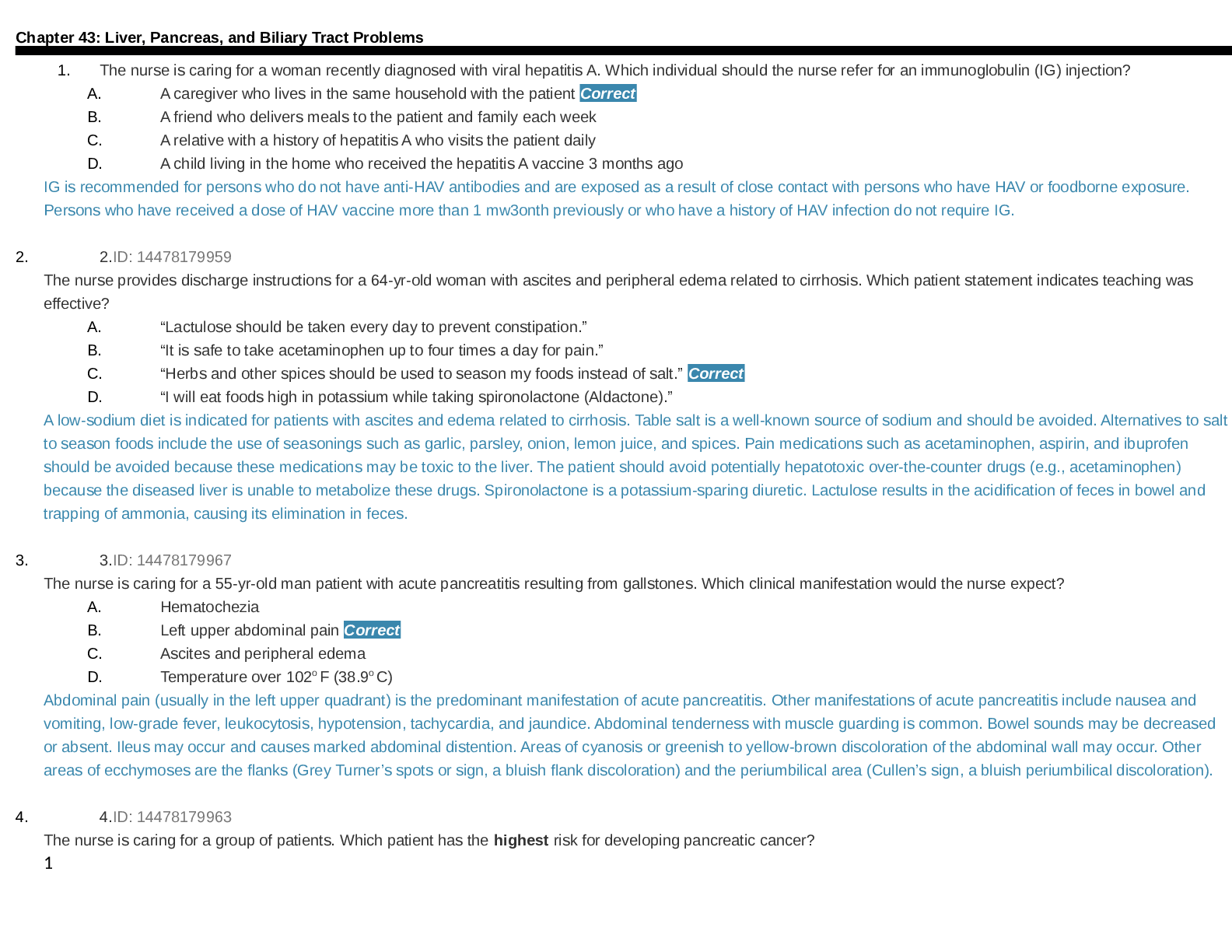
, All Correct, Download to Score A.png)

, 100% Correct, Download to Score A.png)


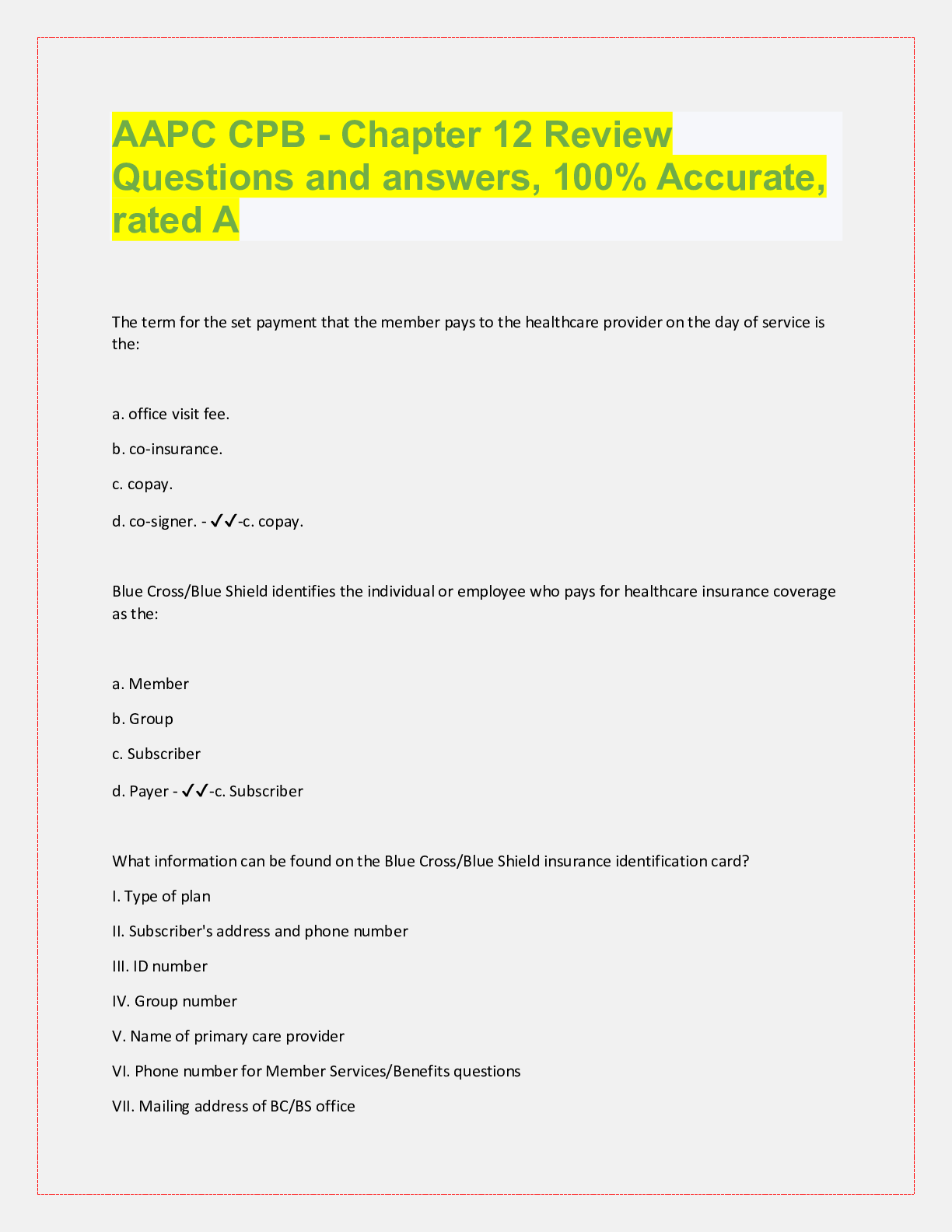
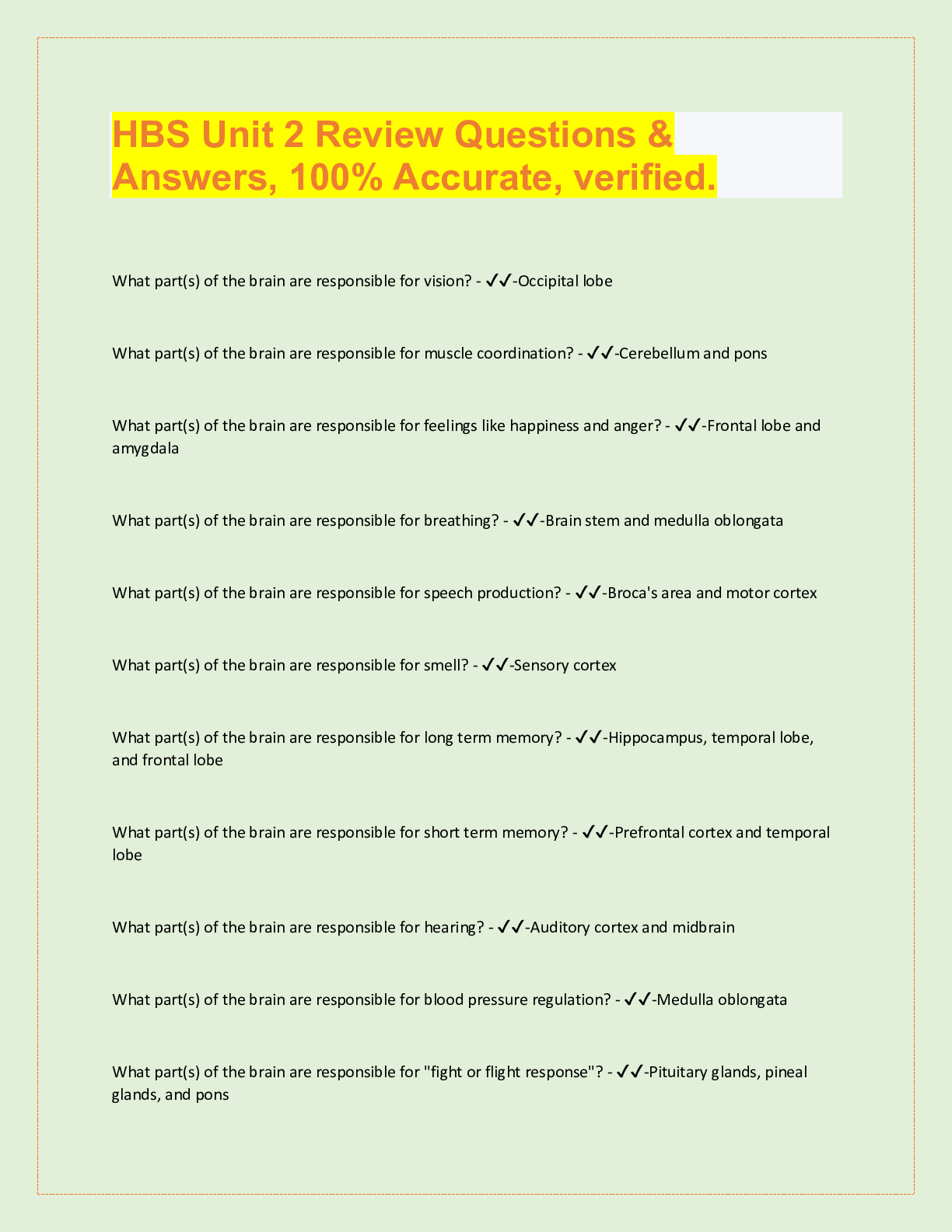
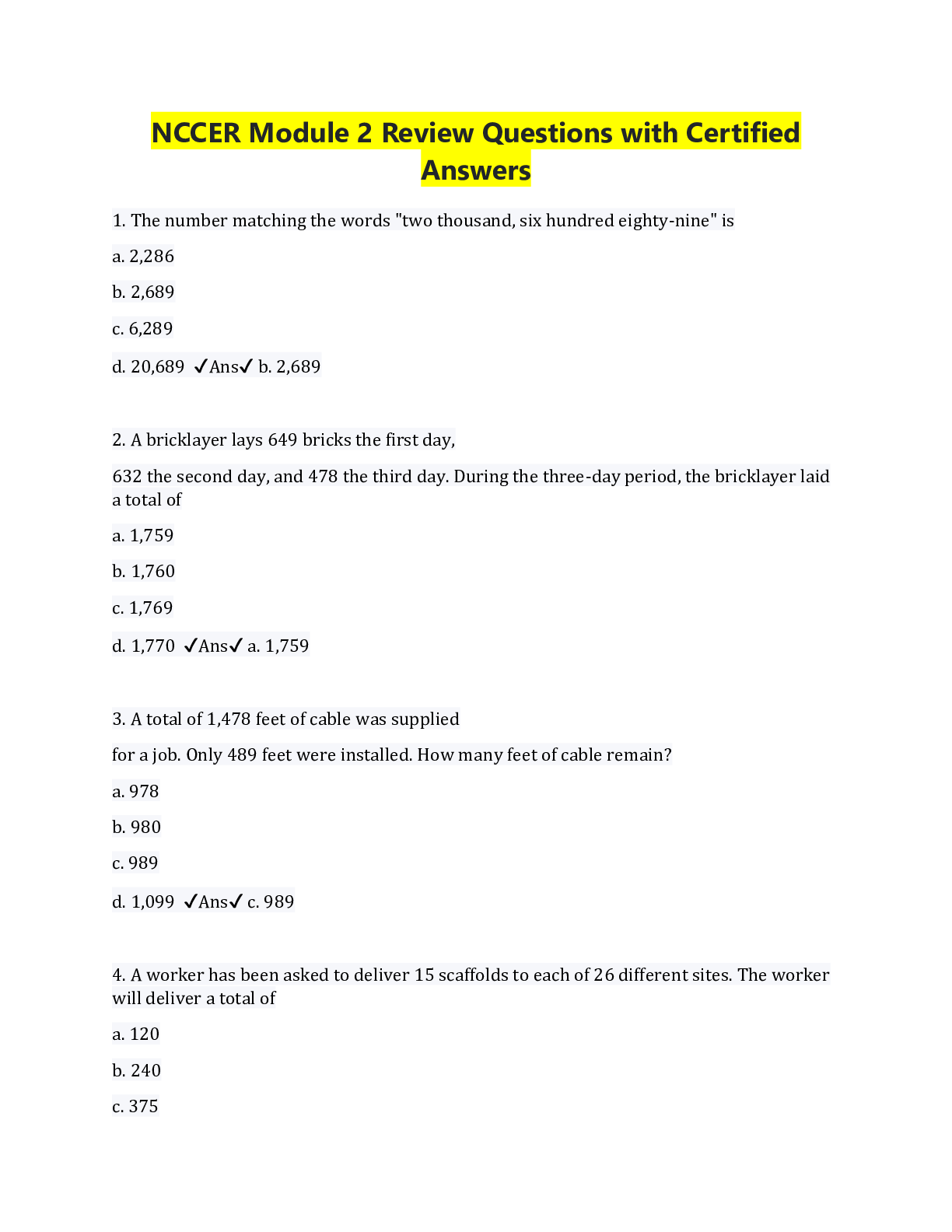
.png)
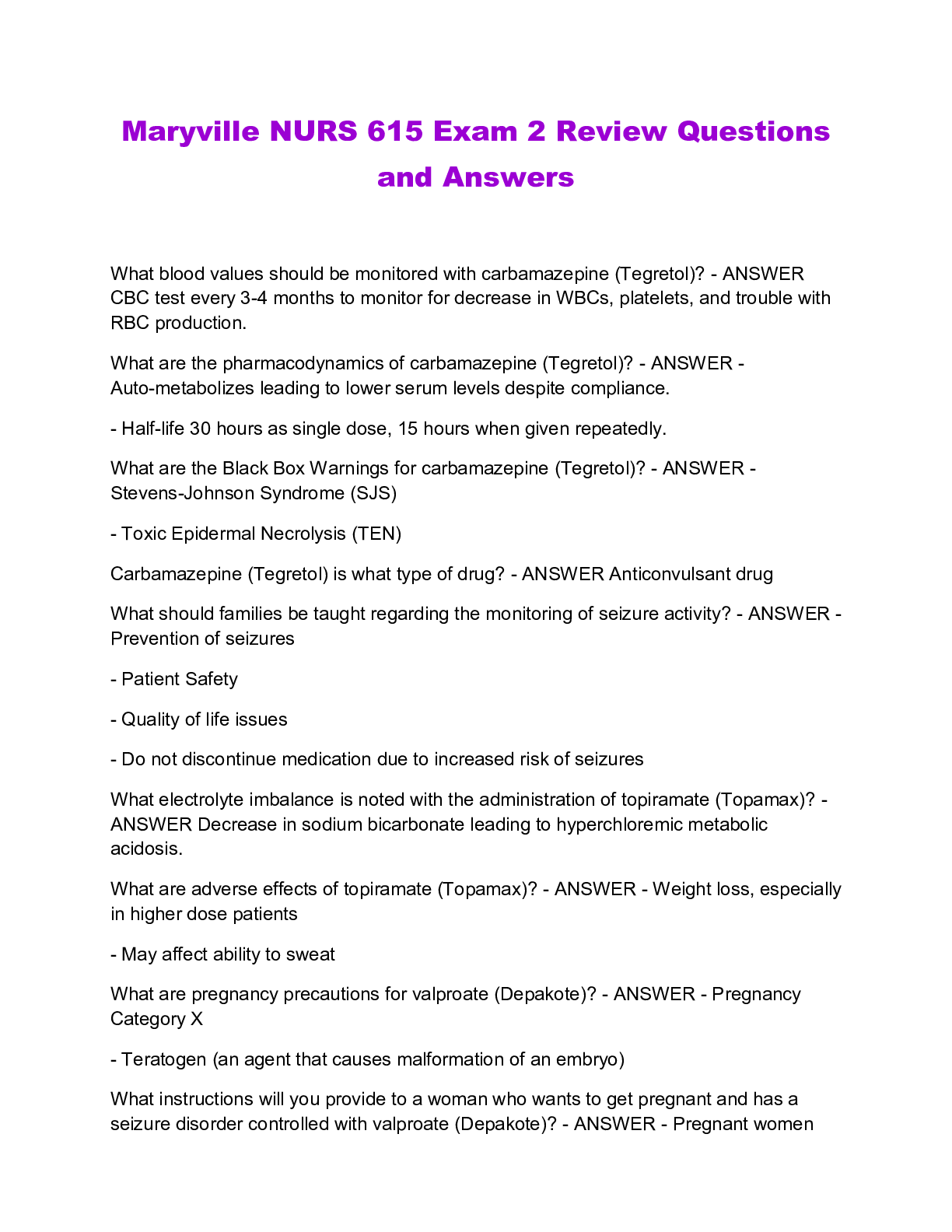
.png)
.png)
.png)
